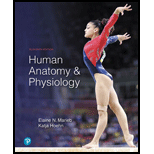
Concept explainers
45-Year-Old Female with Dislocated Hip
In the previous chapter, you met Kayla Tanner, a 45-year-old mother of four who suffered a dislocated right hip in a car accident. Prior to the closed reduction, the doctors noted that her right thigh was flexed at the hip, adducted, and medially rotated. A widened joint space in the postreductionX ray showed that the reduction was not complete, but no bone fragments were visible in the joint space. Mrs. Tanner was scheduled for immediate surgery.

The surgeons discovered that the acetabular labrum had detached from the rim of the acetabulum and was lying deep within the joint space. The detached portion of the labrum was excised, and the hip was surgically reduced. During the early healing phase (first two weeks), Mrs. Tanner was kept in traction with the thigh abducted.
1. How would you structurally and functionally classify the joint involved in the injury in this case?
Want to see the full answer?
Check out a sample textbook solution
Chapter 8 Solutions
Human Anatomy & Physiology (11th Edition)
- QUESTION Identify the bone and the bone marking the arrow is pointing to in the image. O radius; styloid process O radius; head O ulna, olecranon O ulna; styloid processarrow_forwardIdentify the Joints by Structure as either Fibrous, Cartilaginous or Synovial. Based on these, here's what I got: fibrous cartilaginous synovial synovial synovial synovial synovial cartilaginous synovial fibrous fibrous Will that be the correct way?arrow_forwardThe proximal radioulnar joint ________. is supported by the annular Ligament contains an articular disc that strongly unites the bones is supported by the ulnar collateral ligament is a hinge joint that allows for flexion/extension of the forearmarrow_forward
- The pelvis ________. has a subpubic angle that is larger in females consists of the two hip hones, but does not include the sacrum or coccyx has an obturator foramen, an opening that is defined in part by the sacrospinous and sacrotuberous ligaments has a space located inferior to the pelvic brim called the greater pelvisarrow_forwardBoth functional and structural classifications can be used to describe an individual joint. Define the first sternocostal joint and the pubic symphysis using both functional and structural characteristics.arrow_forwardCondyloid joints ________. are a type of ball-and-socket joint include the radiocarpal joint are a uniaxial diarthrosis joint are found at the proximal radioulnar jointarrow_forward
- the epiphyseal plate is a synchondrosis. true or false?arrow_forwardEvan is 25 years old. Would you expect to find synchondroses at the ends of his femur? Explainarrow_forwardActivity 3: Synovial Joint Structure [Note: Functionally – moveable joint (Diarthroses)] Table 11.2/11.3 Note - detailed information about synovial joints can be viewed on p.4 of this guide 1. Note that because all types of vertebrates evolved from a common ancestor, they have similar bones and synovial joints (see example of upper limbs below). In this online class, students are not required to dissect a chicken wing, which is often used to observe examples of synovial joints. However, in the space below, using the drawings below or online sources, please draw the wing of the chicken, labeling the humerus, elbow joint, radius, ulna, wrist joint, carpals, metacarpals, and phalanges: Humerus Carpals Metacarpals O Phalanges Radius Ulna OOOarrow_forward
- QUESTION 7 Identify the bone the arrow is pointing to in the image. O pubis ischium ilium OS Coxaarrow_forwardCase Scenario based upon Skeletal Joints: Leanne, age 48, jumped on her niece's hover board, only to be thrown off quickly. As a result, she separated her right shoulder at an articulating point. An articulation is where two bones come together, otherwise, called a joint. A joint can be defined as the location where two bones come together allowing movement. What is the most commonly separated joint in the shoulder - name the joint and the two bones that articulate? What surrounding tissues might also be damaged? How will the inflammation affect Leanne? What is the difference between a separation and a dislocation? If Leanne had suffered a dislocation, what joint would this be and the bones involved?arrow_forwardMatch the term in column A with the correct description in column B. Column A Column B 1. Articular cartilage a.) C- shaped plate of fibrocartilage that provides shock absorption at the knee joint 2. Interosseous membrane b.) Synchondrosis where bone growth occurs 3. Synovial membrane c.) Layer of hyaline cartilage that covers articulating bony surfaces at synovial joints 4. Bursa d.) Fluid-filled sac that provides cushioning and reduces friction at a synovial joint 5. Fontanelle e.) Structure that anchors a tooth to its bony socket 6. Meniscus f.) Sheet of fibrous connective tissue that connects the long bones in the forearm or leg 7. Intervertebral disc g.) Region of connective tissue between cranial bones in the fetal skull, where ossification is not complete 8. Epiphyseal plate h.) Shock absorbing fibrocartilage located between the bodies of adjacent vertebrae 9. Periodontal…arrow_forward
 Anatomy & PhysiologyBiologyISBN:9781938168130Author:Kelly A. Young, James A. Wise, Peter DeSaix, Dean H. Kruse, Brandon Poe, Eddie Johnson, Jody E. Johnson, Oksana Korol, J. Gordon Betts, Mark WomblePublisher:OpenStax College
Anatomy & PhysiologyBiologyISBN:9781938168130Author:Kelly A. Young, James A. Wise, Peter DeSaix, Dean H. Kruse, Brandon Poe, Eddie Johnson, Jody E. Johnson, Oksana Korol, J. Gordon Betts, Mark WomblePublisher:OpenStax College



